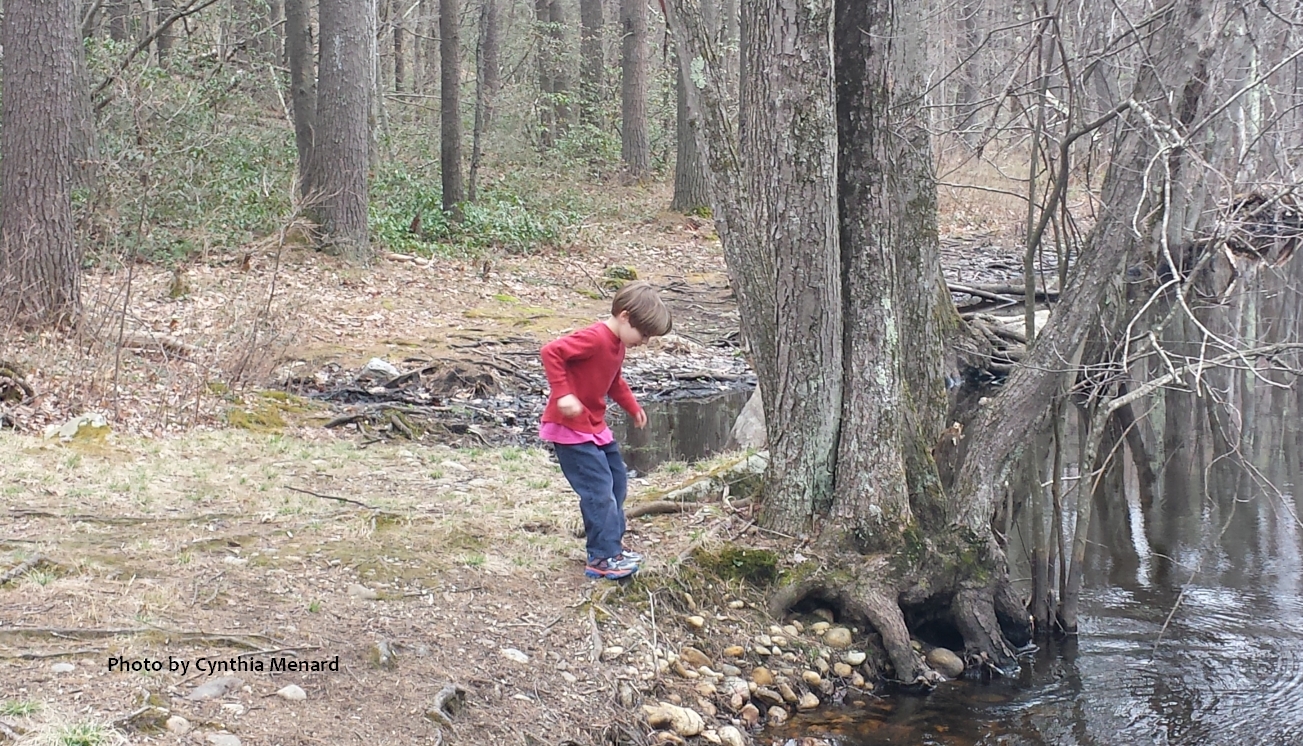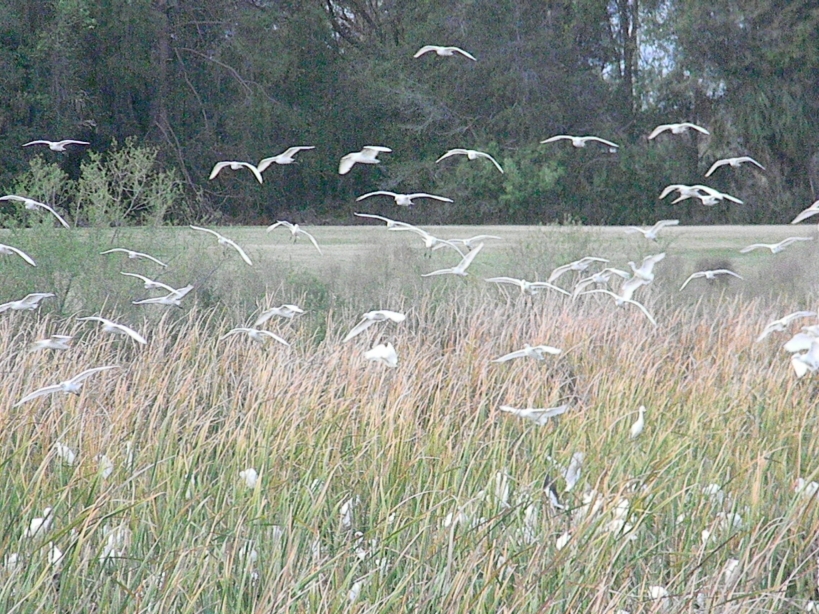This list was inspired by Richard Louv’s article “Ten Ways Camps Can Reduce Nature-Deficit Disorder and Build Support for Their Programs” on his blog The New Nature Movement (a must-read for anyone who works outdoors with children).
1. Get out!!! Don’t be afraid to take kids outdoors for any reason. Some parents and teachers worry that they need to be able to answer their children’s questions about nature. But sometimes not knowing the answer will help your kids – and you – discover much more about the natural world than if you satisfy their curiosity right away (for more on this, see my article on Coyote Teaching). And as long as everyone’s dressed appropriately for the weather, go out rain or shine (or snow, or wind, or heat…).
2. Make sure kids have ‘unstructured’ time outdoors. If you talk to biologists, naturalists, conservationists, foresters, or anyone else who works outdoors for a living (or is just passionate about the natural world), many of them have something in common. Their love for the natural world was formed by spending free and unstructured time in nature – playing, exploring, getting dirty, building forts, etc. as children. This is almost universally true. Let kids have time to explore their world on their terms and they will come to love it on their terms.
3. Join or start up a Family Nature Club. The Children and Nature Network has an amazing resource – the Family Nature Club Toolkit which you can download for free.
4. Send them to camp. Camp is a great way for kids to be outdoors for long stretches of time in a different setting than home or school. And more and more camps are focusing on nature deficit disorder and finding ways to help families combat it. If camp feels like a too-expensive option for you, check it out anyway. Most camps offer ‘camperships’ to help families that might not be able to afford it otherwise.
5. Start a family, school or community garden. Gardening is a terrific way to help kids learn hands-on about some important biological principles, with a fun reward – food! No experience necessary – kids love it when the adults in their lives learn along side them. I’ve included some ‘gardening with kids’ books below in the resources list.
6. Participate in citizen-science projects. These are ongoing research projects through organizations such as Cornell University, Mass Audubon, US Fish & Wildlife and others. They’re a terrific way for kids to see a direct correlation between their work in the outdoors and how it gets used by actual research projects. I documented some citizen-science resources in my Exploring the Outdoors When No One Wants to Go Outdoors article.
7. Walk and play with them in the rain. Showing kids that being outdoors isn’t just for perfect, sunny days is instrumental in their developing attitudes towards the natural world. They (and we) need to be reminded that getting wet or dirty isn’t going to hurt us – and it’s actually pretty fun! Make sure you’re modeling this behavior by joining them in their adventures.
8. Go for a “night hike”. As a culture, we tend to shun the outdoors after dark. But walking (carefully) in the dark will teach you and your charges an amazing amount about the natural world and yourselves. This Nite Hike website by Mary Riley and printable lesson plan from Upham Woods Outdoor Center have some classic activities that teach about communicating and use your senses when sight is limited. I included a must-have book (if you’re interested in exploring the night) at the end of the article as well.
9. Help them connect when they’re indoors, too. I recently wrote an article titled, ‘Exploring the Outdoors When No One Wants to Go Outdoors‘, in the understanding that sometimes the natural world isn’t cooperating and it just isn’t realistic to go out. There are some terrific resources in there to help your kids connect with nature even while sitting in front of a computer screen.
10. Go letterboxing or geocaching. These are two very similar activities which are akin to scavenger hunts in the outdoors. A principle difference between them being that geocaching requires the use of a hand-held GPS unit, while letterboxing does not. There are a few other differences as well, but both operate on the same basic principle: getting a set of directions that lead you to a hidden treasure box where you can sign in and share your adventure. Visit Letterboxing.org and/or Geocaching.com for detailed information on how to get started on either of these super-fun activities.
11. Go camping. ‘Nuff said.
12. Encourage learning how to fish or hunt. Fishing and hunting are activities that are slowly falling by the wayside – but teach valuable skills that are applicable to many parts of our lives. And getting involved in these pursuits naturally brings about a sharp awareness of the natural world which is much-needed for our younger generations. Your state fish and wildlife department is a great place to start for resources and classes, and many states are now offering classes aimed specifically at women.
13. Do it now!!! It doesn’t matter what your background is, where you live, or how old the children in your care are. There’s no reason not to get started right this instant – nature is all around us waiting to be discovered, and to share its marvels and mysteries with those who take the time to look for them.
Helpful resources:
Last Child in the Woods: Saving Our Children from Nature-Deficit Disorder
Gardening with Children
How to Grow a School Garden: A Complete Guide for Parents and Teachers
Keepers of the Night: Native American Stories and Nocturnal Activities for Children
The Letterboxer’s Companion: Exploring the Mysteries Hidden in the Great Outdoors
The Geocaching Handbook: The Guide for Family Friendly, High-Tech Treasure Hunting

Get the Thursday Thirteen code here
View More Thursday Thirteen Participants



These are great! I’m pretty good with at least half of this list. The other half, I’ll start working on. I’ve been observing with my boys a squirrel and a blue bird moving some shelled peanuts around in our gardens over the past couple days. (Someone left peanuts in our garden. Who knows why.) It’s been fun to observe and talk about what they might be doing and why. Simple, fun entertainment!
Love it!! So fun to wildlife watch with kids, they’re amazed by so many things we take for granted.
An excellent list. And yes, educational too. I’m quite interested in the gardening bit.
Scrolled down your posts. So sorry about your Freya. I’m an animal lover, specially dogs. Glad you are safe from the fire.
Thanks for your condolences, Hazel. Let me know how the garden goes!
Loved your 13 ideas nature with the kids. 13 is my lucky number too. Loved the feeling of your enthusiasm through your writing. Your ideas sound such ful!
It’s a pity my daughter has grown up and has left the nest. No doubt I’ll find someone else to join me as I ramble through the countryside.
Jenni x
Until recently, my favorite walking companion was my dog (she’s no longer with us), but I’m just as happy to go wandering by myself. Then I don’t have anyone complaining that I’m taking too long to look at the tracks, or birds, or anything else. 🙂 My oldest son is a good project for this post – he’s not nearly as outdoorsy as I am and needs the encouragement…